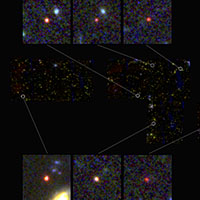Webb Space Telescope locates ancient, massive galaxies that disrupt current cosmological theory
posted Thursday, February 23, 2023 at 1:30 PM EDT

One of the primary goals of the James Webb Space Telescope is to further humanity's understanding of the ancient universe. Sometimes to expand our understanding, we must thoroughly disrupt it first. A new study by an international team of astrophysicists has discovered mysterious objects in images captured by Webb, including six potential galaxies. If these are galaxies, then they are so massive and old that current cosmological theory can't explain their existence.
As reported by the University of Colorado Boulder and first seen on Reddit, the candidate galaxies might have existed roughly 500 to 700 million years following the Big Bang, making the galaxies more than 13 billion years old. The potential galaxies may contain nearly as many stars as the Milky Way Galaxy today.
Erica Nelson, co-author of the new research and assistant professor of astrophysics at CU Boulder, says, "It's bananas. You just don't expect the early universe to be able to organize itself that quickly. These galaxies should not have had time to form."
Nelson and her colleagues, including primary author Ivo Labbé of the Swinburne University of Technology in Australia, published their results on February 22 in Nature. The research describes that one of the candidate galaxies has a possible stellar mass of about 1011 solar masses. If this mass is verified by spectroscopy, the stellar mass density would be "much higher than anticipated from previous studies based on rest-frame ultraviolet-selected samples."

Credits: NASA, ESA, CSA, I. Labbe (Swinburne University of Technology). Image processing: G. Brammer (Niels Bohr Institute’s Cosmic Dawn Center at the University of Copenhagen).
The newly-observed prospective galaxies aren't the oldest spotted yet by Webb, as scientists have previously identified galaxies that likely formed around 350 million years after the Big Bang, but the newly-spotted galaxies are significantly larger than those older galaxies.
Researchers must do more work to confirm that the galaxies are, in fact, galaxies, and are as large as they appear. Gravitational lensing, which is when a huge amount of matter in space warps the light from objects behind it, can warp light and make measurements challenging. However, preliminary observations are promising. The potential is there for the new research to "rewrite astronomy textbooks." However, as Nelson says, "Another possibility is that these things are a different kind of weird object, such as faint quasars, which would be just as interesting."
In 2022, Nelson and her colleagues, who are from the United States, Australia, Denmark, and Spain, formed an ad hoc team to investigate data Webb sent back to Earth. The team's recent findings are based on Webb's Cosmic Evolution Early Release Science (CEERS) survey. The CEERS images look at a specific patch of sky near the Big Dipper. The area was first investigated by Hubble in the 1990s, and at first glance, it seems to be a somewhat boring bit of sky.
Nelson was investigating a tiny section of an image when she spotted a few "fuzzy dots" of light that appeared too bright. "They were so red and so bright, " Nelson says. "We weren't expecting to see them." For astronomers, red light is often old light. The galaxy is continuously expanding, which spreads objects out. As the emitted light from objects is stretched, it appears redder. If an object becomes closer to an observation point, it appears bluer.
Following Nelson's observation, the team began investigating the "fuzzy dots," finding that the possible galaxies were not just old but huge. Based on calculations, those tiny dots are home to as many as hundreds of billions of sun-sized stars worth of mass, similar to the Milky Way.

Credits: NASA GSFC/CIL/Adriana Manrique Gutierrez
However, despite similar mass to the Milky Way, that doesn't mean the old galaxies are much like our home galaxy. "The Milky Way forms one to two new stars every year," says Nelson. "Some of these galaxies would have to be forming hundreds of new stars every. Year for the entire history of the universe."
Therein lies the rub. If these galaxies contain as many stars and as much mass as it appears, then there shouldn't have been enough matter at that time in the universe to allow that level of star formation. "If even one of these galaxies is real, it will push against the limits of our understanding of cosmology," Nelson says.
Nelson has long been passionate about space. She wrote a report about Hubble when she was 10 years old and was instantly hooked. "It takes time for light to go from a galaxy to us, which means that you're looking back in time when you're looking at these objects," she says. "I found that concept so mind-blowing that I decided at that instant that this was what I wanted to do with my life." It's amazing to see Nelson go from becoming interested in studying deep space because of an elementary school report on Hubble to being at the forefront of changing humanity's understanding of space with the James Webb Space Telescope.
To read the preliminary research, visit Nature. The paper, "A population of red candidate massive galaxies ~600 Myr after the Big Bang," is written by Ivo Labbé, Pieter van Dokkum, Erica Nelson, Rachel Bezanson, Katherine A. Suess, Joel Leja, Gabriel Brammer, Katherine Whitaker, Elijah Matthews, Mauro Stefanon, and Bingjie Wang.